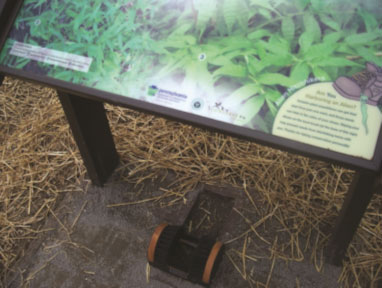Plan Now, Benefit Later:
Invasive Species Best Management Practices – Part 2
Alexandra Wardwell
Human activities can exacerbate the spread of non-native invasive species around the world as well as in Indiana. In some cases, our involvement with these non-native invasive species introductions was purposeful and with the best intentions in mind. In other cases, invasive species were unknowingly and unintentionally distributed and spread. Invasive species are a serious threat to species biodiversity, our environment, our economy, and even to our health.
The Indiana Invasive Species Council has a working group called the Invasive Plant Advisory Committee (www.entm.purdue.edu/iisc/plantcommittee.php) that has put together a Top Ten List of Invasive Species Best Management Practices. This list can help woodland owners and land managers make good decisions limiting the introduction and spread of problem species. It is unlikely all ten will be able to be implemented at once but it is a goal to work towards. Choose the easiest of these to implement first and work from there. The first five tips were printed in Part 1, published in the previous issue of the Woodland Steward. The next five are listed below.
1. Keep tools, vehicles, and equipment clean.
Require contractors to bring clean equipment to your site. A good idea is to designate a cleaning and disposal area where you can clean vehicles and equipment off. Educate and encourage others to inspect and clean clothing, vehicles, and equipment before and after entry to site (Figure 1). One easy way to clean boots and boot treads is to carry a small hand held boot brush with you in your pack to use when you leave an area and before you enter a new area.
2. Come up with a long term plan for managing invasives on the site.
As Benjamin Franklin said “An ounce of prevention is worth a pound of cure”.
Prioritize locations and species while taking into account:
• Severity of infestation
• Degree of the species invasiveness
• Feasibility of control
• Value of habitat at risk
“Optimize” treatment timing and technique (this is often species specific based on the life cycle of the plant. Evaluate, measure, and document your success!
3. Monitor disturbed locations and high risk areas regularly.
This is especially important following natural disasters like floods or tornados as well as major development or maintenance projects. Monitor areas that are free of invasive species but are near infested sites.
4. Require contractors to follow BMPs.
Incorporate BMP requirements into RFPs and contracts. Inspecting and documenting infestations before and after contractor activity is smart. Ask for guarantees or make-good provisions.
5. Educate your neighbors and recreational users on Invasive Species BMPs:
Provide basic education when possible:
• What are invasive species?
• Why are they bad?
• How to identify key species and how they spread
Provide cleaning stations at key entry and exit points. This can be as simple as a boot brush for foot traffic but needs to be more substantial for equipment and vehicle cleaning (Figure 2). Regulate entry of infested material when possible (campfire wood, hay, bait, etc.).
In addition to the BMPs, look for funding opportunities, partnerships, and volunteers to assist in preventing and reducing invasive species. Work goes faster and is more fun when working in a group! Working to control invasive plants can be frustrating at times, but by understanding the invasive species you are dealing with and by implementing invasive species BMPs you can work smarter and more strategically to reduce their spread.
To view and print the BMPs visit the Invasive Plant Advisory Committee’s website www.entm.purdue.edu/iisc/index.php and click on the blue BMP tab.
For trusted sources of native seeds visit the INPAWS webpage www.inpaws.org/landscaping/sources-of-indiana-native-plants/.
Alexandra Wardwell is the Project Director of Southern Indiana Cooperative Invasives Management or SICIM. SICIM is a non-profit cooperative weed management area that covers 35 counties in southern Indiana. For more information about SICIM please visit our website www.sicim.info.
 Figure 1. A free vehicle and recreation equipment washing station (invasive.org)
Figure 1. A free vehicle and recreation equipment washing station (invasive.org)
 Figure 2. A boot brush station and invasive species prevention sign at a state forest in Pennsylvania. (dcnr.state.pa.us)
Figure 2. A boot brush station and invasive species prevention sign at a state forest in Pennsylvania. (dcnr.state.pa.us)
